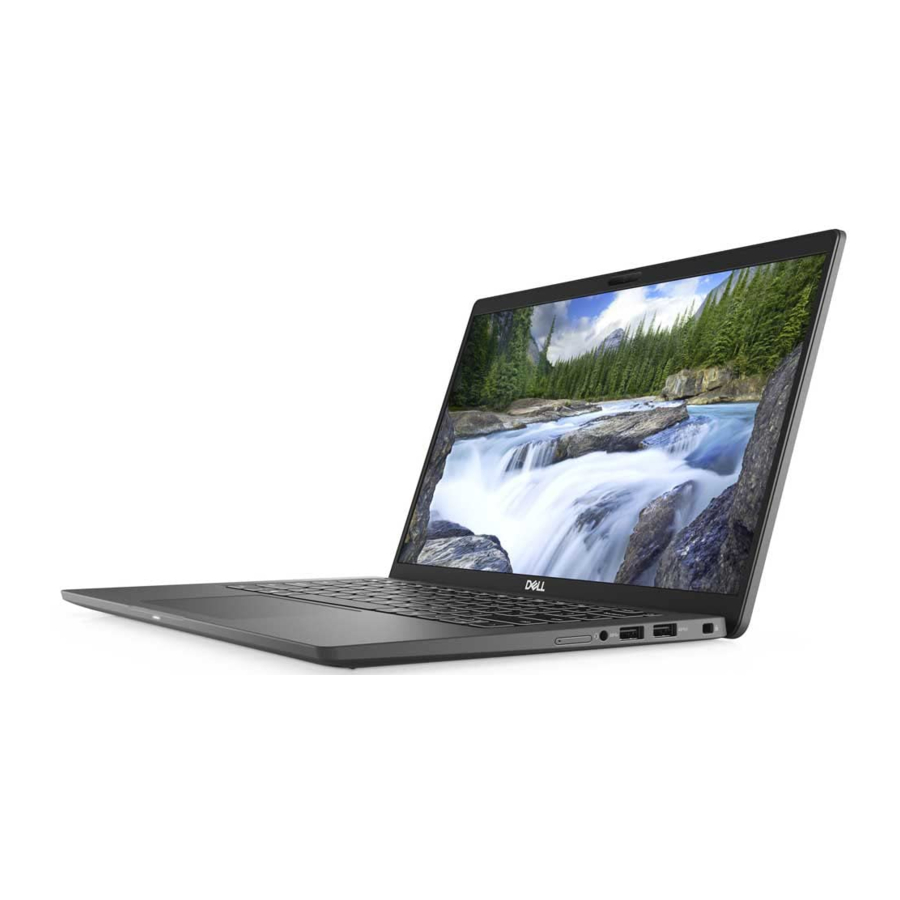
Dell Latitude 7310 Manual
- Service manual (63 pages) ,
- Quick start manual (18 pages) ,
- Setup and specifications (42 pages)
Advertisement
- 1 Set up your computer
- 2 Chassis overview
- 3 Keyboard shortcuts
-
4
Specifications of Latitude 7310
- 4.1 Dimensions and weights
- 4.2 Processors
- 4.3 Chipset
- 4.4 Operating system
- 4.5 Memory
- 4.6 External ports
- 4.7 Internal connectors
- 4.8 Wireless module
- 4.9 Audio
- 4.10 Storage
- 4.11 Media-card reader
- 4.12 Keyboard
- 4.13 Camera
- 4.14 Touchpad
- 4.15 Fingerprint reader (optional)
- 4.16 Power adapter
- 4.17 Battery
- 4.18 Display
- 4.19 GPU—Integrated
- 4.20 Computer environment
- 4.21 Security
- 5 System setup
- 6 Software
- 7 Getting help and contacting Dell
- 8 Notes, cautions, and warnings
- 9 Documents / Resources

Set up your computer
About this task
This section discusses setting up your Dell Latitude 7310 system for the first time, including setting up the Internet connectivity and, personalizing with Dell apps.
Steps
- Connect the power adapter and press the power button.
![Dell - Latitude 7310 - Set up your computer Set up your computer]()
NOTE: To conserve battery power, the battery might enter power-saving mode.
- Finish operating system initial setup.
For Windows:- Connect to a network or Windows updates.
![]()
NOTE: If connecting to a secured wireless network, enter the password for the wireless network access when prompted.
- Sign in to your Microsoft account or create an account.
![]()
- On the Support and Protection screen, enter your contact details.
For Ubuntu:
Follow the on-screen instructions to complete the setup. For more information about installing and configuring Ubuntu, see the knowledge base articles SLN151664 and SLN151748 at www.dell.com/support.
- Connect to a network or Windows updates.
- Locate and use Dell apps from the Windows Start menu — Recommended.
Table 1. Locate Dell apps
 | Dell Product Registration Register your system unit with Dell. |
 | Dell Help and Support Access help and support for your system.  |
 | SupportAssist
|
 | Dell Update Utility updates your system with critical fixes and important device drivers as they become available. |
 | Dell Digital Delivery Download software applications including software that is purchased but not preinstalled on your system. |
NOTE: Create a recovery drive to troubleshoot and fix problems that may occur with Windows. Create recovery drive for Windows. For more information, see Create a USB recovery drive for Windows.
Chassis overview
Display view
Laptop

- RGB or IR Camera (optional)
- Camera status LED
- LCD panel
- Battery status LED
2-in-1
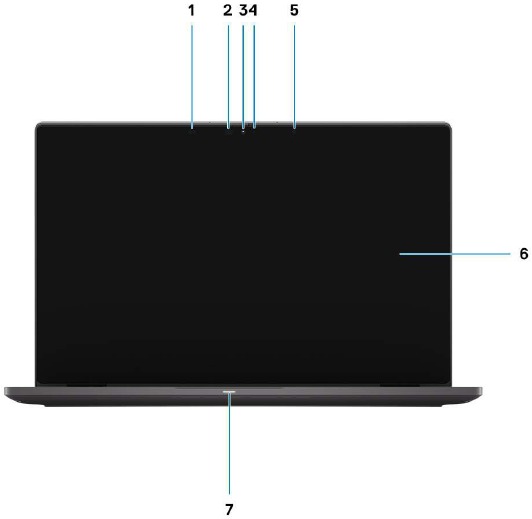
- Proximity sensor
- IR emitter (optional)
- RGB or IR Camera (optional)
- Camera status LED
- Ambient Light Sensor (ALS) sensor
- LCD panel
- Battery status LED
Palmrest view
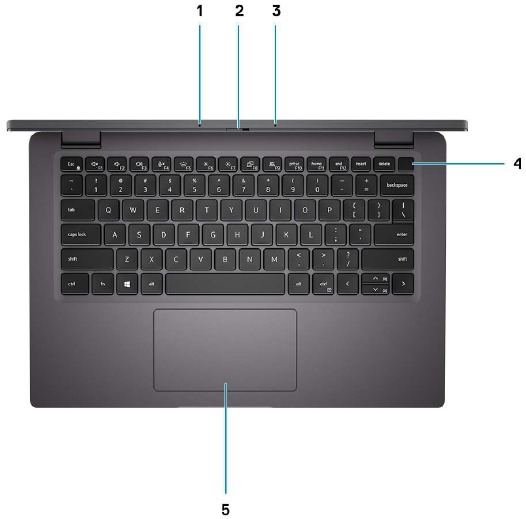
- Microphone array
- SafeView switch
- Microphone array
- Power button (Optional: Fingerprint reader)
- Touchpad
Left view

- HDMI 2.0 port
- USB 3.2 Gen 2 Type-C port with DisplayPort (alt mode), Thunderbolt 3.0 with Power Delivery(PD)
- USB 3.2 Gen 2 Type-C port with DisplayPort (alt mode) and Thunderbolt 3.0 with PD
- micro-SD card reader slot
- Smart card reader slot (optional)
Right view

- SIM card slot (optional with WWAN configuration only)
- Universal Audio Jack
- USB 3.2 Gen 1 Type-A port with PowerShare
- Wedge shaped lock slot
Bottom view
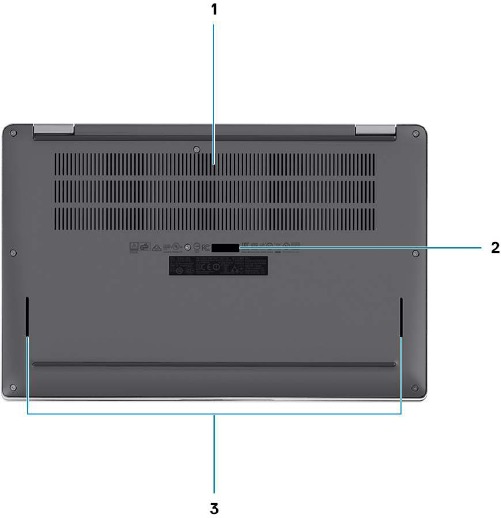
- Cooling vents
- Service tag label
- Speaker grills
Modes
This section illustrates various usage modes of a Latitude 7310 Laptop and 2-in-1 computer:
Notebook mode
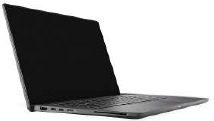

2-in-1 Modes

Tablet mode
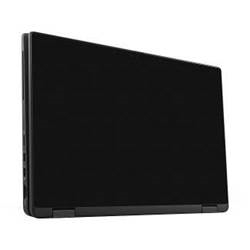
Stand mode
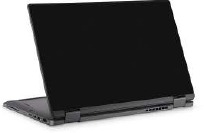
Tent mode

Keyboard shortcuts
This section describes the primary and secondary function associated with each of the Function Keys and their combination with function lock.

Some keys on your keyboard have two symbols on them. These keys can be used to type alternate characters or to perform secondary functions. The symbol shown on the lower part of the key refers to the character that is typed out when the key is pressed. If you press shift and the key, the symbol shown on the upper part of the key is typed out. For example, if you press 2, 2 is typed out; if you press Shift + 2, @ is typed out.
The keys F1-F12 at the top row of the keyboard are function keys for multi-media control, as indicated by the icon at the bottom of the key. Press the function key to invoke the task represented by the icon. For example, pressing F1 mutes the audio (refer to the table below).
However, if the function keys F1-F12 are needed for specific software applications, multi-media functionality can be disabled by pressing Fn + esc. Subsequently, multimedia control can be invoked by pressing Fn and the respective function key. For example, mute audio by pressing Fn + F1.

Table 2. List of function shortcuts
| Keys | Primary behavior | Secondary behavior (Fn + Key) |
| Esc | Esc | Fn Toggle |
| F1 | Speaker mute | F1 behavior |
| F2 | Volume decrease (-) | F2 behavior |
| F3 | Volume increase (+) | F3 behavior |
| F4 | Mic mute | F4 behavior |
| F5 | Keyboard backlight | F5 behavior |
| F6 | Screen brightness down (-) | F6 behavior |
| F7 | Screen brightness up (+) | F7 behavior |
| F8 | Toggle display (Win+P) | F8 behavior |
| F9 | Toggle e-Privacy panel (optional with ePrivacy panel)) | F9 behavior |
| F10 | Print screen | F10 behavior |
| F11 | Home | F11 behavior |
| F12 | End | F12 behavior |
List of other keyboard shortcuts
Table 3. List of other keyboard shortcuts
| Function key combinations | Behavior |
 | Pause/Break |
 | Toggle scroll lock |
 | System request |
 | Open application menu |
Table 4. List of other keyboard shortcuts
| Function key combinations | Behavior |
| Fn+Ctrl+B | Break |
| Fn+Shift+B | Unobtrusive mode
|
Fn+Up Arrow ( ) ) | Page-up |
Fn+Down Arrow ( ) ) | Page-down |
Specifications of Latitude 7310
Dimensions and weights
The following table lists the height, width, depth, and weight of your Latitude 7310.
Laptop
Table 5. Dimensions and weight
| Description | Values |
| Height: | |
| 0.69 in. (17.55 mm) |
| 0.72 in. (18.27 mm) |
| Width | 12.07 in. (306.5 mm) |
| Depth | 8.0 in. (203.19 mm) |
| Weight (starting) | 2.69 lb (1.22 kg) |
2-in-1
Table 6. Dimensions and weight
| Description | Values |
| Height: | |
| 0.67 in. (17.07 mm) |
| 0.76 in. (19.21 mm) |
| Width | 12.07 in. (306.5 mm) |
| Depth | 8.0 in. (203.19 mm) |
| Weight (starting) | 2.91 lb (1.32 kg) |

Processors
Table 7. Processors
| Description | Values | |||
| Processors | 10th Generation Intel Core i5-10210U (non-vPro) | 10th Generation Intel Core i5-10310U (vPro) | 10th Generation Intel Core i7-10610U (vPro) | 10th Generation Intel Comet Lake Core i7-10810U (vPro) |
| Wattage | 15 W | 15 W | 15 W | 15 W |
| Core count | 4 | 4 | 4 | 6 |
| Thread count | 8 | 8 | 8 | 12 |
| Speed | 1.6 GHz to 4.2 GHz | 1.7 GHz to 4.4 GHz | 1.8 to 4.9 GHz | 1.1 GHz to 4.9 GHz |
| Cache | 6 MB | 6 MB | 8 MB | 12 MB |
| Integrated graphics | Intel UHD Graphics | Intel UHD Graphics | Intel UHD Graphics | Intel UHD Graphics |
Chipset
Table 8. Chipset
| Description | Values |
| Chipset | Intel Comet Lake U PCH |
| Processor | 10th Generation Intel Come Lake Core i5/i7 processors |
| DRAM bus width | 64-bit |
| PCIe bus | Up to Gen3 |
Operating system
- Windows 10 Home (64-bit)
- Windows 10 Professional (64-bit)
- Ubuntu 18.04 LTS (not available for 2-in-1 system configurations)
Memory
The following table lists the memory specifications of your Latitude 7310.
Table 9. Memory specifications
| Description | Values |
| Memory slots | Built on system board |
| Memory type | Dual-channel DDR4 |
| Memory speed | 2666 MHz |
| Maximum memory configuration | 32 GB |
| Minimum memory configuration | 4 GB |
| Memory configurations supported |
|
External ports
The following table lists the external ports on your Latitude 7310.
Table 10. External ports
| Description | Values |
| USB ports |
|
| Audio port | One Universal Audio Jack |
| Video port |
|
| Media-card reader | One micro-SD Card reader |
| Docking port | Supported by USB Type-C port |
| Power-adapter port | Two USB 3.2 Gen 2 Type-C ports with Power Delivery |
| Security | One Wedge-shaped lock slot |
Internal connectors
Table 11. Internal ports and connectors
| Description | Values |
| One M.2 Key-M (2280 or 2230) for solid-state drive |
|
| One M.2 2230 Key-E for WWAN card |
|
 NOTE: To learn more about the features of different types of M.2 cards, see the knowledge base article SLN301626. NOTE: To learn more about the features of different types of M.2 cards, see the knowledge base article SLN301626. | |
Wireless module
The following table lists the Wireless Local Area Network (WLAN) and Wireless Wide Area Network (WWAN) module specifications of your Latitude 7310.
WLAN modules
The WiFi module on this system is built on the system board.
Table 12. Wireless module specifications
| Description | Option one | Option two |
| Model number | Intel Wireless-AC 9560, 2x2, 802.11ac with Bluetooth 5.1 (non-vpro) | Intel Wi-Fi 6 AX201, 2x2, 802.11ax with Bluetooth 5.1 (vpro) |
| Transfer rate |
|
|
| Frequency bands supported | 2.4 GHz/5 GHz | 2.4 GHz/5 GHz |
| Wireless standards | IEEE 802.11a/b/g/n/ac MU-MIMO RX | IEEE 802.11a/b/g/n/ac/ax, 160MHz channel use |
| Encryption |
|
|
| Bluetooth | Bluetooth 5.1 | Bluetooth 5.1 |
WWAN modules
The following list provides the mobile broadband module options available on Latitude 7310
- 2-in-1:
- Qualcomm Snapdragon X20 Gigabit LTE CAT 16 (DW5821e; e-SIM enabled), WW excluding China, Turkey, US
- Qualcomm Snapdragon X20 Gigabit LTE CAT 16 (DW5821e) WW
- Qualcomm Snapdragon X20 Gigabit LTE CAT 16 (DW5821e) for AT&T, Verizon and Sprint, US only
- Laptop:
- Qualcomm Snapdragon X20 LTE-A CAT 9 (DW5829e; e-SIM enabled) WW excluding China, Turkey, US
- Qualcomm Snapdragon X20 LTE-A CAT 9 (DW5829e) WW
- Qualcomm Snapdragon X20 LTE-A CAT 9 (DW5829e) for AT&T, Verizon and Sprint, US only
Audio
Table 13. Audio specification
| Descriptions | Values |
| Type | High-definition audio |
| Controller | Realtek ALC3254 |
| Stereo conversion | Supported |
| Internal interface | High-definition audio |
| External interface | Universal audio jack |
| Speakers | Two |
| Internal speaker amplifier | Supported (audio codec integrated) |
| External volume controls | Keyboard shortcut controls |
| Speaker output: | |
| 2 W |
| 2.5 W |
| Microphone | Dual-array microphones |
Storage
This section lists the storage options on your Latitude 7310.
Your computer supports one of the following configurations:
- M.2 2230, PCIe x4 NVMe, Class 35 SSD
- M.2 2280, PCIe x4 NVMe, Class 40 SSD
- M.2 2280, PCIe x4 NVMe, Class 40 SED

Table 14. Storage specifications
| Storage type | Interface type | Capacity |
| M.2 2230, PCIe x4 NVMe, Class 35 SSD | PCIe x4 NVMe 3.0 | up to 512 GB |
| M.2 2280, PCIe x4 NVMe, Class 40 SSD | PCIe x4 NVMe 3.0 | up to 1 TB |
| M.2 2280, PCIe x4 NVMe, Class 40 SED | PCIe x4 NVMe 3.0 | up to 512 GB |
Media-card reader
Table 15. Media-card reader specifications
| Description | Values |
| Type | micro-SD Card reader |
| Cards supported |
|
Keyboard
Table 16. Keyboard specifications
| Description | Values |
| Type |
|
| Layout | QWERTY/KANJI |
| Number of keys |
|
| Size | X=18.07 mm key pitch Y=18.07 mm key pitch |
| Shortcut keys | Some keys on your keyboard have two symbols on them. These keys can be used to type alternate characters or to perform secondary functions. To type the alternate character, press Shift and the desired key. To perform secondary functions, press Fn and the desired key. For more information see the Keyboard shortcuts section.
|
Camera
The following table lists the camera specifications of your Latitude 7310.
Table 17. Camera specifications
| Description | Values |
| Number of cameras | One |
| Camera type |
|
| Camera location | Front |
| Camera sensor type | CMOS sensor technology |
| Camera resolution: | |
| 1280 x 720 (HD) |
| 1280 x 720 (HD) at 30 fps |
| Infrared camera resolution: | |
| 1280 x 720 (HD) |
| 1280 x 720 (HD) at 30 fps |
| Diagonal viewing angle: | |
| 78.6 degrees |
| 78.6 degrees |
Touchpad
Table 18. Touchpad specifications
| Description | Values |
| Resolution: | |
| 3054 |
| 1790 |
| Dimensions: | |
| 105 mm (4.13 in.) |
| 65 mm (2.56 in.) |
Touchpad gestures
For more information about touchpad gestures for Windows 10, see the Microsoft knowledge base article 4027871 at support.microsoft.com.
Fingerprint reader (optional)
The following table lists the specifications of the optional fingerprint-reader of your Latitude 7310.
Table 19. Fingerprint reader specifications
| Description | Values | |
| Option 1 | Option 2 | |
| Fingerprint-reader sensor technology | Capacitive | Capacitive |
| Fingerprint-reader sensor resolution (dpi) | 363 | 500 |
| Fingerprint-reader sensor pixel size | 76 x 100 | 108 x 88 |
Power adapter
The following table lists the power adapter specifications of your Latitude 7310.
Table 20. Power adapter specifications
| Description | Option one | Option two |
| Type | 65 W, USB Type-C adapter | 90 W, USB Type-C adapter |
| Input voltage | 100 VAC/240 VAC | 100 VAC/240 VAC |
| Input frequency | 50 Hz/60 Hz | 50 Hz/60 Hz |
| Input current (maximum) | 1.50 A | 1.70 A |
| Output current (continuous) | 3.25 A | 4.5 A |
| Rated output voltage | 19.50 VDC | 19.50 VDC |
| Temperature range: | ||
| 0°C to 40°C (32°F to 104°F) | 0°C to 40°C (32°F to 104°F) |
| -40°C to 70°C (-40°F to 158°F) | -40°C to 70°C (-40°F to 158°F) |
Battery
Table 21. Battery specifications
| Specifications | Option 1 | Option 2 | Option 3 |
| Type | Li-ion Polymer, 3-cell 39 WHr | Li-ion Polymer, 4-cell 52 WHr | Li-ion Polymer, 4-cell 52 WHr (LCL) |
| Voltage (VDC) | 11.4 V | 7.6 V | 7.6 V |
| Weight (maximum) | 0.207 kg (0.46 lb) | 0.257 kg (0.56 lb) | 0.257 kg (0.56 lb) |
| Dimensions: | |||
| 251 mm (9.88 in.) | 251 mm (9.88 in.) | 251 mm (9.88 in.) |
| 85.8 mm (3.38 in.) | 85.8 mm (3.38 in.) | 85.8 mm (3.38 in.) |
| 5 mm (0.19 in.) | 5 mm (0.19 in.) | 5 mm (0.19 in.) |
| Temperature range: | |||
|
| ||
| -20°C to 60°C (-4°F to 140°F) | ||
| Battery Operating time | Varies depending on operating conditions and can significantly reduce under certain power-intensive conditions. | ||
| Battery Charging time (approximate) |
 NOTE: Control the charging time, duration, start and end time, and so on using the Dell Power Manger application. For more information on the Dell Power Manger see, https://www.dell.com/support/home/product-support/product/power-manager/docs NOTE: Control the charging time, duration, start and end time, and so on using the Dell Power Manger application. For more information on the Dell Power Manger see, https://www.dell.com/support/home/product-support/product/power-manager/docs | ||
| Life span (approximate) | 1 Year or 300 discharge/charge cycles | 3 Years or 1000 discharge/charge cycles | |
| ExpressCharge | Supported | Supported | Supported |
| User replaceable | No (FRU) | No (FRU) | No (FRU) |
| Coin-cell battery | Main battery reserves 2% of capacity for RTC function. | ||
| Coin-cell Operating time | 68 days with 39 WHr battery
| ||

For batteries with the ExpressCharge feature, the battery will typically have at least an 80% charge after about an hour of charging with the system off, and fully charged in about 2 hours with the system off.
Enabling ExpressCharge requires that both the computer and the battery used be ExpressCharge capable. If these requirements are not met, ExpressCharge will not be enabled.
Display
The following tables lists the display specifications of your Latitude 7310.
Table 22. 2-in-1 Display specifications
| Description | Options 1 | Option 2 |
| Display type | 13-in. FHD SLP with Corning Gorilla Glass 6 (GG6) | 13-in. FHD Digital Privacy SafeScreen with GG6 |
| Display-panel technology | Wide Viewing Angle (WVA) | Wide Viewing Angle (WVA) |
| Display-panel dimensions (active area): | ||
| 165.24 mm (6.50 in.) | 165.24 mm (6.50 in.) |
| 293.76 (11.56 in.) | 293.76 mm (11.56 in.) |
| 337.08 mm (13.3 in.) | 337.08 mm (13.3 in.) |
| Display-panel native resolution | 1920 x 1080 | 1920 x 1080 |
| Luminance (typical) | 270 | 270 |
| Megapixels | 2.07 | 2.07 |
| Color gamut | sRGB 100% | sRGB 100% |
| Pixels Per Inch (PPI) | 166 | 166 |
| Contrast ratio (min) | 1000:1 | 1000:1 |
| Response time (max) | 35 ms | 35 ms |
| Refresh rate | 60 Hz | 60 Hz |
| Horizontal view angle | 80/80 degrees (min) |
|
| Vertical view angle | 80/80 degrees (min) |
|
| Pixel pitch | 0.153 mm | 0.153 mm |
| Power consumption (maximum) | 2.2 W + 0.16 W (Touch) |
|
| Anti-glare vs glossy finish | Anti-reflection/Anti-Smudge coating | Anti-reflection/Anti-smudge coating |
| Touch options | Touch with Active Pen Support | Touch with Active Pen Support |
Table 23. Laptop display specifications
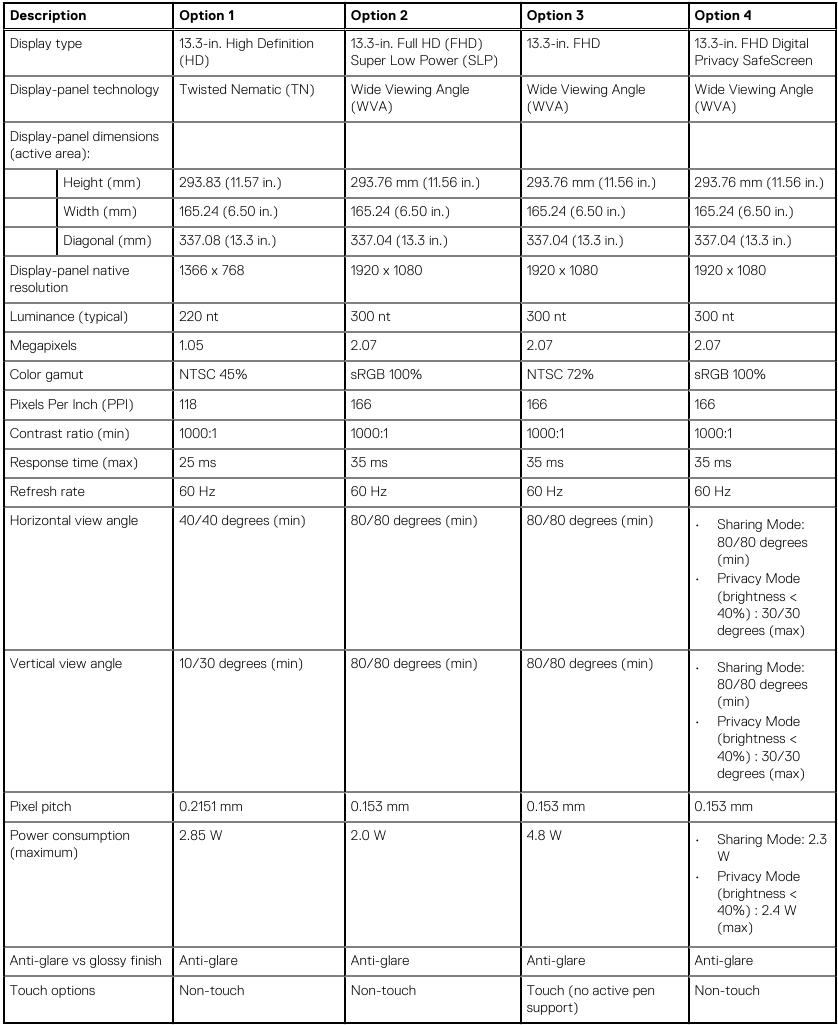
GPU—Integrated
The following table lists the specifications of the integrated Graphics Processing Unit (GPU) supported by your Latitude 7310.
Table 24. GPU—Integrated
| Controller | External display support | Memory size | Processor |
| Intel UHD Graphics |
| Shared system memory | 10th Generation Intel Comet Lake Core i5/i7 processors |
Computer environment
Airborne contaminant level: G1 as defined by ISA-S71.04-1985
Table 25. Computer environment
| Description | Operating | Storage |
| Temperature range | Normal ambient condition 25°C and 40~50% 0°C to Normal ambient condition 25°C and 40~50% 40°C (32°F to 104°F) | -40°C to 65°C (-40°F to 149°F) |
| Relative humidity (maximum) | Normal ambient condition 25°C and 40~50% 10% to Normal ambient condition 25°C and 40~50% 90% (non-condensing) | 10% to 95% (non-condensing) |
| Vibration (maximum)* | 0.66 GRMS | 1.30 GRMS |
| Shock (maximum) | 140 G† | 160 G† |
| Altitude (maximum) | 0 m to 3048 m (0 ft to 10,000 ft) | 0 m to 10,688 m (0 ft to 35,000 ft) |
* Measured using a random vibration spectrum that simulates user environment.
† Measured using a 2 ms half-sine pulse when the hard drive is in use.
‡ Measured using a 2 ms half-sine pulse when the hard-drive head is in parked position.
Security
Table 26. Security
| Feature | Specifications |
| Trusted Platform Module (TPM) 2.0 | Integrated on the system board |
| Firmware TPM | Optional |
| Windows Hello Support | Yes, optional fingerprint on power button Optional IR camera |
| Cable lock | Wedge-shaped lock |
| Dell Smartcard Keyboard | Optional |
| FIPS 140-2 certification for TPM | Yes |
| ControlVault 3 Advanced Authentication with FIPS 140-2 Level 3 Certification | Yes, for FPR, SC and CSC/NFC |
| Fingerprint Reader Only | Touch Fingerprint reader in power button tied to ControlVault 3 |
| Contacted Smart Card and ControlVault 3 | FIPS 201 Smart card reader certification/SIPR |
System setup
Unless you are an expert computer user, do not change the settings in the BIOS Setup program. Certain changes can make your computer work incorrectly.


Use the BIOS Setup program for the following purposes:
- Get information about the hardware installed in your computer, such as the amount of RAM and the size of the hard drive.
- Change the system configuration information.
- Set or change a user-selectable option, such as the user password, type of hard drive installed, and enabling or disabling base devices.
Entering BIOS setup program
About this task
Turn on (or restart) your computer and press F2 immediately.
Navigation keys

Table 27. Navigation keys
| Keys | Navigation |
| Up arrow | Moves to the previous field. |
| Down arrow | Moves to the next field. |
| Enter | Selects a value in the selected field (if applicable) or follow the link in the field. |
| Spacebar | Expands or collapses a drop-down list, if applicable. |
| Tab | Moves to the next focus area.
|
| Esc | Moves to the previous page until you view the main screen. Pressing Esc in the main screen displays a message that prompts you to save any unsaved changes and restarts the system. |
Boot Sequence
Boot Sequence allows you to bypass the System Setup–defined boot device order and boot directly to a specific device (for example:
optical drive or hard drive). During the Power-on Self Test (POST), when the Dell logo appears, you can:
- Access System Setup by pressing F2 key
- Bring up the one-time boot menu by pressing F12 key
The one-time boot menu displays the devices that you can boot from including the diagnostic option. The boot menu options are:
- Removable Drive (if available)
- STXXXX Drive (if available)

- Optical Drive (if available)
- SATA Hard Drive (if available)
- Diagnostics

The boot sequence screen also displays the option to access the System Setup screen.
One time boot menu
To enter one time boot menu, turn on your computer, and then press F2 immediately.

The one-time boot menu displays the devices that you can boot from including the diagnostic option. The boot menu options are:
- Removable Drive (if available)
- STXXXX Drive (if available)
NOTE: XXX denotes the SATA drive number.
- Optical Drive (if available)
- SATA Hard Drive (if available)
- Diagnostics
NOTE: Choosing Diagnostics, will display the SupportAssist diagnostics screen.
The boot sequence screen also displays the option to access the System Setup screen.
System setup options

Table 28. System setup options—System information menu
Overview
| BIOS Version | Displays the BIOS version number. |
| Service Tag | Displays the Service Tag of the computer. |
| Asset Tag | Displays the Asset Tag of the computer. |
| Ownership Tag | Displays the ownership tag of the computer. |
| Manufacture Date | Displays the manufacture date of the computer. |
| Ownership Date | Displays the ownership date of the computer. |
| Express Service Code | Displays the express service code of the computer. |
| Ownership Tag | Displays the ownership tag of the computer. |
| Signed Firmware Update | Displays whether the signed firmware update is enabled. |
| Battery | Displays the battery health information. |
| Primary | Displays the primary battery. |
| Battery Level | Displays the battery level. |
| Battery State | Displays the battery state. |
| Health | Displays the battery health. |
| AC Adapter | Displays whether an AC adapter is installed. |
| Processor Information | |
| Processor Type | Displays the processor type. |
| Maximum Clock Speed | Displays the maximum processor clock speed. |
| Core Count | Displays the number of cores on the processor. |
| Processor L2 Cache | Displays the processor L2 Cache size. |
| Processor ID | Displays the processor identification code. |
| Processor L3 Cache | Displays the processor L3 Cache size. |
| Current Clock Speed | Displays the current processor clock speed. |
| Minimum Clock Speed | Displays the minimum processor clock speed. |
| Microcode Version | Displays the microcode version. |
| Intel Hyper-Threading Capable | Displays whether the processor is Hyper-Threading (HT) capable. |
| 64-Bit Technology | Displays whether 64-bit technology is used. |
| Memory Information | |
| Memory Installed | Displays the total computer memory installed. |
| Memory Available | Displays the total computer memory available. |
| Memory Speed | Displays the memory speed. |
| Memory Channel Mode | Displays single or dual channel mode. |
| Memory Technology | Displays the technology that is used for the memory. |
| Device Information | |
| Video Controller | Displays the integrate graphics information of the computer. |
| dGPU Video Controller | Displays the discrete graphics information of the computer. |
| Video BIOS Version | Displays the video BIOS version of the computer. |
| Video Memory | Displays the video memory information of the computer. |
| Panel Type | Displays the Panel Type of the computer. |
| Native Resolution | Displays the native resolution of the computer. |
| Audio Controller | Displays the audio controller information of the computer. |
| Wi-Fi Device | Displays the wireless device information of the computer. |
| Bluetooth Device | Displays the Bluetooth device information of the computer. |
Table 29. System setup options—Boot options menu
Boot options
| Advanced Boot Options | |
| Enable UEFI Network Stack | Enables or disables UEFI Network Stack. Default: OFF. |
| Boot Mode | |
| Boot Mode: UEFI only | Displays the boot mode of this computer. |
| Enable Boot Devices | Enables or disables boot devices for this computer. |
| Boot Sequence | Displays the boot sequence. |
| BIOS Setup Advanced Mode | Enables or disables advanced BIOS settings. Default: ON. |
| UEFI Boot Path Security | Enables or disables the system to prompt the user to enter the Admin password when booting a UEFI boot path from the F12 boot menu. Default: Always Except Internal HDD. |
Table 30. System setup options—System Configuration menu
System Configuration
| Date/Time | |
| Sets the computer date in MM/DD/YYYY format. Changes to the date take effect immediately. |
| Sets the computer time in HH/MM/SS 24-hour format. You can switch between 12hour and 24-hour clock. Changes to the time take effect immediately. |
| Enable SMART Reporting | Enables or disables SMART (Self-Monitoring, Analysis, and Reporting Technology) during computer startup to report hard drive errors. Default: OFF. |
| Enable Audio | Enables or disables all integrated audio controller. Default: ON. |
| Enable Microphone | Enables or disables microphone. Default: ON. |
| Enable Internal Speaker | Enables or disables internal speaker. Default: ON. |
| USB Configuration | |
| Enables or disables booting from USB mass storage devices such as external hard drive, optical drive, and USB drive. |
| Enables or disables USB ports to be functional in an operating system environment. |
| SATA Operation | Configures operating mode of the integrated SATA hard drive controller. Default: RAID. SATA is configured to support RAID (Intel Rapid Restore Technology). |
| Drives | Enables or disables various onboard drives. |
| M.2 PCIe SSD-0/SATA-2 | Default: ON. |
| SATA-0 | Default: ON. |
| Drive Information | Displays the information of various onboard drives. |
| Miscellaneous Devices | Enables or disables various onboard devices. |
| Enable Camera | Enables or disables the camera. Default: ON. |
| Keyboard Illumination | Configures the operating mode of the keyboard illumination feature. Default: Disabled. The keyboard illumination will always be off. |
| Keyboard Backlight Timeout on AC | Configures the timeout value for the keyboard when an AC adapter is connected to the computer. The keyboard backlight timeout value is only effect when the backlight is enabled. Default: 10 seconds. |
| Keyboard Backlight Timeout on Battery | Configures the timeout value for the keyboard when the computer is running on battery. The keyboard backlight timeout value is only effect when the backlight is enabled. Default: 10 seconds. |
| Touchscreen | Enables or disables the touchscreen for the operating system.
Default: ON. |
Table 31. System setup options—Video menu
Video
| LCD Brightness
EcoPower | Sets the screen brightness when the computer is running on battery power. Sets the screen brightness when the computer is running on AC power. Enables or disables EcoPower which increases the battery life by reducing the screen brightness when appropriate. |
Table 32. System setup options—Security menu
Security
| Enable Admin Setup Lockout | Enables or disables the user from entering BIOS Setup when an Admin Password is set. Default: OFF. |
| Password Bypass | Bypass the System (Boot) Password and the internal hard drive password prompts during a system restart. Default: Disabled. |
| Enable Non-Admin Password Changes | Enables or disables the user to change the system and hard drive password without the need for admin password. Default: ON. |
| Non-Admin Setup Changes | |
| Allow Wireless Switch Changes | Enables or disables changes to the setup option when an Administrator password is set. Default: OFF. |
| Enable UEFI Capsule Firmware Updates | Enables or disables BIOS updates through UEFI capsule update packages. |
| Computrace | Enable or disable the BIOS module interface of the optional Computrace(R) Service from Absolute Software. |
| Intel Platform Trust Technology On | Enables or disables Platform Trust Technology (PTT) visibility to the operating system. Default: ON. |
| PPI Bypass for Clear Commands | Enables or disables the operating system to skip BIOS Physical Presence Interface (PPI) user prompts when issuing the Clear command. Default: OFF. |
| Clear | Enables or disables the computer to clear the PTT owner information, and returns the PTT to the default state. Default: OFF. |
| Intel SGX | Enables or disables the Intel Software Guard Extensions (SGX) to provide a secured environment for running code/storing sensitive information. Default: Software Control |
| SMM Security Mitigation | Enables or disables additional UEFI SMM Security Mitigation protections.
|
| Enable Strong Passwords | Enables or disables strong passwords. Default: OFF. |
| Password Configuration | Control the minimum and maximum number of characters that are allowed for Admin and System passwords. |
| Admin Password | Sets, Changes, or deletes the administrator (admin) password (sometimes called the "setup" password). |
| System Password | Sets, Changes, or deletes the system password. |
| Enable Master Password Lockout | Enables or disables the master password support. Default: OFF. |
Table 33. System setup options—Secure Boot menu
Secure Boot
| Enable Secure Boot | Enables or disables the computer to boos using only validated boot software.
|
| Secure Boot Mode | Selects the Secure Boot operation mode.
|
Table 34. System setup options—Expert Key Management menu
Expert Key Management
| Enable Custom Mode | Enables or disables the keys in the PK, KEK, db, and dbx security key databases to be modified. Default: OFF. |
| Custom Mode Key Management | Selects the custom values for expert key management. Default: PK. |
Table 35. System setup options—Performance menu
Performance
| Intel Hyper-Threading Technology | Enables or disables the Intel Hyper-Threading Technology to use processor resources more efficiently. Default: ON. |
| Intel SpeedStep | Enables or disables the Intel SpeedStep Technology to dynamically adjust processor voltage and core frequency, decreasing average power consumption and heat production. Default: ON. |
| Intel TurboBoost Technology | Enabled or disabled the Intel TurboBoost mode of the processor. If enabled, the Intel TurboBoost driver increases the performance of the CPU or graphics processor. Default: ON. |
| Multi-Core Support | Changes the number of CPU cores available to the operating system. The default value is set to the maximum number of cores. Default: All Cores. |
| Enable C-State Control | Enables or disables the CPU's ability to enter and exit low-power states. Default: ON. |
Table 36. System setup options—Power Management menu
Power Management
| Wake on AC | Enables the computer to turn on and go to boot when AC power is supplied to the computer. Default: OFF. |
| Auto on Time | Enables the computer to automatically power on for defined days and times. Default: Disabled. The system will not automatically power up. |
| Battery Charge Configuration | Enables the computer to run on battery during power usage hours. Use the below options to prevent AC power usage between certain times of each day. Default: Adaptive. Battery settings are adaptively optimized based on your typical battery usage pattern. |
| Enable Advanced Battery Charge Configuration | Enables Advanced Battery Charge Configuration from the beginning of the day to a specified work period. Advanced Battery Charged maximizes battery health while still supporting heavy use during the work day. Default: OFF. |
| Block Sleep | Blocks the computer from entering Sleep (S3) mode in the operating system.
|
| Enable USB Wake Support | Enables the USB devices to wake the computer from Standby mode. Default: OFF. |
| Enable Intel Speed Shift Technology | Enables or disables Intel Speed Shift Technology support which enables the operating system to select the appropriate processor performance automatically. Default: ON. |
| Lid Switch | Enables the computer to power up from the off state whenever the lid is opened. Default: ON. |
Table 37. System setup options—Wireless menu
Wireless
| Wireless Switch | Determines which wireless devices can be controlled by the Wireless Switch. For Windows 8 systems, this is controlled by an operating system drive directly. As a result, the setting does not affect the Wireless Switch behavior.
|
| WLAN | Default: ON. |
| Bluetooth | Default: ON. |
| Wireless Device Enable | Enable or disable internal WLAN/Bluetooth devices. |
| WLAN | Default: ON. |
| Bluetooth | Default: ON. |
Table 38. System setup options—POST Behavior menu
POST Behavior
| Numlock Enable | Enables or disables Numlock when the computer boots. Default: ON. |
| Enable Adapter Warnings | Enables the computer to display adapter warning messages during boot. Default: ON. |
| Extend BIOS POST Time | Configures the BIOS POST (Power-On Self-Test) load time. Default: 0 seconds. |
| Fastboot | Configures the speed of the UEFI boot process. Default: Thorough. Performs complete hardware and configuration initialization during boot. |
| Fn Lock Options | Enables or disables the Fn lock mode. Default: ON. |
| Lock Mode | Default: Lock Mode Secondary. Lock Mode Secondary = If this option is selected, the F1-F12 keys scan the code for their secondary functions. |
| Pull Screen Logo | Enabled or disabled the computer to display full screen logo if the image match screen resolution. Default: OFF. |
| Warnings and Errors | Selects an action on encountering a warning or error during boot.
|
Table 39. System setup options—Virtualization menu
Virtualization
| Intel Virtualization Technology | Enables the computer to run a virtual machine monitor (VMM). Default: ON. |
| VT for Direct I/O | Enables the computer to perform Virtualization Technology for Direct I/O (VT-d). VT-d is an Intel method that provides virtualization for memory map I/O. Default: ON |
Table 40. System setup options—Maintenance menu
Maintenance
| Asset Tag | Creates a system Asset Tag that can be used by an IT administrator to uniquely identify a particular system. Once set in BIOS, the Asset Tag cannot be changed. |
| Service Tag | Displays the Service Tag of the computer. |
| BIOS Recovery from Hard Drive | Enables the computer to recover from a bad BIOS image, as long as the Boot Block portion is intact and functioning.
|
| BIOS Auto-Recovery | Enables the computer to automatically recover the BIOS without user actions. This feature requires BIOS Recovery from Hard Drive to be set to Enabled. Default: OFF. |
| Start Data Wipe |
If enabled, the BIOS will queue up a data wipe cycle for storage devices that are connected to the motherboard on the next reboot. |
| Allow BIOS Downgrade | Controls flashing of the system firmware to previous revisions. Default: ON. |
Table 41. System setup options—System Logs menu
System Logs
| Power Event Log | Displays Power events. Default: Keep. |
| BIOS Event Log | Displays BIOS events. Default: Keep. |
| Thermal Event Log | Displays Thermal events. Default: Keep. |
Table 42. System setup options—SupportAssist menu
SupportAssist
| Dell Auto operating system Recovery Threshold | Controls the automatic boot flow for SupportAssist System Resolution Console and for Dell operating system Recovery tool. Default: 2. |
| SupportAssist operating system Recovery | Enables or disables the boot flow for SupportAssist operating system Recovery tool in the even of certain system errors. Default: ON. |
Clearing BIOS (System Setup) and System passwords
About this task
To clear the system or BIOS passwords, contact Dell technical support as described at www.dell.com/contactdell.

Software
This chapter details the supported operating systems along with instructions on how to install the drivers.
Operating system
- Windows 10 Home (64-bit)
- Windows 10 Professional (64-bit)
- Ubuntu 18.04 LTS (not available for 2-in-1 system configurations)
Downloading the audio driver
Steps
- Turn on your computer.
- Go to www.dell.com/support.
- Enter the Service Tag of your computer, and then click Submit.
NOTE: If you do not have the Service Tag, use the auto-detect feature or manually browse for your computer model.
- Click Drivers & downloads.
- Click the Detect Drivers button.
- Review and agree to the Terms and Conditions to use SupportAssist, then click Continue.
- If necessary, your computer starts to download and install SupportAssist.
NOTE: Review on-screen instructions for browser-specific instructions.
- Click View Drivers for My System.
- Click Download and Install to download and install all driver updates detected for your computer.
- Select a location to save the files.
- If prompted, approve requests from User Account Control to make changes on the system.
- The application installs all drivers and updates identified.
NOTE: Not all files can be installed automatically. Review the installation summary to identify if manual installation is necessary.
- For manual download and installation, click Category.
- Click Audio in the drop-down list.
- Click Download to download the audio driver for your computer.
- After the download is complete, navigate to the folder where you saved the audio driver file.
- Double-click the audio driver file icon and follow the instructions on the screen to install the driver.
Downloading the graphics driver
Steps
- Turn on your computer.
- Go to www.dell.com/support.
- Enter the Service Tag of your computer, and then click Submit.
NOTE: If you do not have the Service Tag, use the auto-detect feature or manually browse for your computer model.
- Click Drivers & downloads.
- Click the Detect Drivers button.
- Review and agree to the Terms and Conditions to use SupportAssist, then click Continue.
- If necessary, your computer starts to download and install SupportAssist.
NOTE: Review on-screen instructions for browser-specific instructions.
- Click View Drivers for My System.
- Click Download and Install to download and install all driver updates detected for your computer.
- Select a location to save the files.
- If prompted, approve requests from User Account Control to make changes on the system.
- The application installs all drivers and updates identified.
NOTE: Not all files can be installed automatically. Review the installation summary to identify if manual installation is necessary.
- For manual download and installation, click Category.
- Click Video in the drop-down list.
- Click Download to download the graphics driver for your computer.
- After the download is complete, navigate to the folder where you saved the graphics driver file.
- Double-click the graphics driver file icon and follow the instructions on the screen to install the driver.
Downloading the USB driver
Steps
- Turn on your computer.
- Go to www.dell.com/support.
- Enter the Service Tag of your computer, and then click Submit.
NOTE: If you do not have the Service Tag, use the auto-detect feature or manually browse for your computer model.
- Click Drivers & downloads.
- Click the Detect Drivers button.
- Review and agree to the Terms and Conditions to use SupportAssist, then click Continue.
- If necessary, your computer starts to download and install SupportAssist.
NOTE: Review on-screen instructions for browser-specific instructions.
- Click View Drivers for My System.
- Click Download and Install to download and install all driver updates detected for your computer.
- Select a location to save the files.
- If prompted, approve requests from User Account Control to make changes on the computer.
- The application installs all drivers and updates identified.
NOTE: Not all files can be installed automatically. Review the installation summary to identify if manual installation is necessary.
- For manual download and installation, click Category.
- Click Chipset in the drop-down list.
- Click Download to download the USB driver for your computer.
- After the download is complete, browse the folder where you saved the USB driver file.
- Double-click the USB driver file icon and follow the instructions on the screen to install the driver.
Downloading the WiFi driver
Steps
- Turn on your computer.
- Go to www.dell.com/support.
- Enter the Service Tag of your computer, and then click Submit.
NOTE: If you do not have the Service Tag, use the auto-detect feature or manually browse for your computer model.
- Click Drivers & downloads.
- Click the Detect Drivers button.
- Review and agree to the Terms and Conditions to use SupportAssist, then click Continue.
- If necessary, your computer starts to download and install SupportAssist.
NOTE: Review on-screen instructions for browser-specific instructions.
- Click View Drivers for My System.
- Click Download and Install to download and install all driver updates detected for your computer.
- Select a location to save the files.
- If prompted, approve requests from User Account Control to make changes on the system.
- The application installs all drivers and updates identified.
NOTE: Not all files can be installed automatically. Review the installation summary to identify if manual installation is necessary.
- For manual download and installation, click Category.
- Click Network in the drop-down list.
- Click Download to download the WiFi driver for your computer.
- After the download is complete, navigate to the folder where you saved the WiFi driver file.
- Double-click the WiFi driver icon and follow the instructions on the screen to install the driver.
Downloading the media-card reader driver
Steps
- Turn on your computer.
- Go to www.dell.com/support.
- Enter the Service Tag of your computer, and then click Submit.
NOTE: If you do not have the Service Tag, use the auto-detect feature or manually browse for your computer model.
- Click Drivers & downloads.
- Click the Detect Drivers button.
- Review and agree to the Terms and Conditions to use SupportAssist, then click Continue.
- If necessary, your computer starts to download and install SupportAssist.
NOTE: Review on-screen instructions for browser-specific instructions.
- Click View Drivers for My System.
- Click Download and Install to download and install all driver updates detected for your computer.
- Select a location to save the files.
- If prompted, approve requests from User Account Control to make changes on the system.
- The application installs all drivers and updates identified.
NOTE: Not all files can be installed automatically. Review the installation summary to identify if manual installation is necessary.
- For manual download and installation, click Category.
- Click Chipset in the drop-down list.
- Click Download to download the media-card reader driver for your computer.
- After the download is complete, navigate to the folder where you saved the media-card reader driver file.
- Double-click the media-card reader driver file icon and follow the instructions on the screen to install the driver.
Downloading the chipset driver
Steps
- Turn on your computer.
- Go to www.dell.com/support.
- Enter the Service Tag of your computer, and then click Submit.
NOTE: If you do not have the Service Tag, use the auto-detect feature or manually browse for your computer model.
- Click Drivers & downloads.
- Click the Detect Drivers button.
- Review and agree to the Terms and Conditions to use SupportAssist, then click Continue.
- If necessary, your computer starts to download and install SupportAssist.
NOTE: Review on-screen instructions for browser-specific instructions.
- Click View Drivers for My System.
- Click Download and Install to download and install all driver updates detected for your computer.
- Select a location to save the files.
- If prompted, approve requests from User Account Control to make changes on the computer.
- The application installs all drivers and updates identified.
NOTE: Not all files can be installed automatically. Review the installation summary to identify if manual installation is necessary.
- For manual download and installation, click Category.
- Click Chipset in the drop-down list.
- Click Download to download the chipset driver for your computer.
- After the download is complete, browse the folder where you saved the chipset driver file.
- Double-click the chipset driver file icon and follow the instructions on the screen to install the driver.
Downloading the network driver
Steps
- Turn on your computer.
- Go to www.dell.com/support.
- Enter the Service Tag of your computer, and then click Submit.
NOTE: If you do not have the Service Tag, use the auto-detect feature or manually browse for your computer model.
- Click Drivers & downloads.
- Click the Detect Drivers button.
- Review and agree to the Terms and Conditions to use SupportAssist, then click Continue.
- If necessary, your computer starts to download and install SupportAssist.
NOTE: Review on-screen instructions for browser-specific instructions.
- Click View Drivers for My System.
- Click Download and Install to download and install all driver updates detected for your computer.
- Select a location to save the files.
- If prompted, approve requests from User Account Control to make changes on the system.
- The application installs all drivers and updates identified.
NOTE: Not all files can be installed automatically. Review the installation summary to identify if manual installation is necessary.
- For manual download and installation, click Category.
- Click Network in the drop-down list.
- Click Download to download the network driver for your computer.
- After the download is complete, navigate to the folder where you saved the network driver file.
- Double-click the network driver file icon and follow the instructions on the screen to install the driver.
Getting help and contacting Dell
Self-help resources
You can get information and help on Dell products and services using these self-help resources:
Table 43. Self-help resources
| Self-help resources | Resource location |
| Information about Dell products and services | https://www.dell.com/ |
| Dell Support |  |
| Tips |  |
| Contact Support | In Windows search, type Contact Support, and press Enter. |
| Online help for operating system |
|
| Troubleshooting information, user manuals, set up instructions, product specifications, technical help blogs, drivers, software updates, and so on. | https://www.dell.com/support/home/ |
| Dell knowledge base articles for various of system concerns: |
|
Learn and get more information about your product:
| Dell provides several online and telephone-based support and service options. If you do not have an active Internet connection, you can find contact information about your purchase invoice, packing slip, bill, or Dell product catalog.
|
Contacting Dell
Dell provides several online and telephone-based support and service options. If you do not have an active Internet connection, you can find contact information about your purchase invoice, packing slip, bill, or Dell product catalog. Availability varies by country/region and product, and some services may not be available in your area. To contact Dell for sales, technical support, or customer service issues:
- Go to https://www.dell.com/support/.
- Select your country/region from the drop-down menu on the lower right corner of the page.
- For customized support:
- Enter your system Service Tag in the Enter your Service Tag field.
- Click submit.
- The support page that lists the various support categories is displayed.
- For general support:
- Select your product category.
- Select your product segment.
- Select your product.
- The support page that lists the various support categories is displayed.
- For contact details of Dell Global Technical Support, see https://www.dell.com/contactdell.
NOTE: The Contact Technical Support page is displayed with details to call, chat, or email the Dell Global Technical Support team.

Notes, cautions, and warnings

A NOTE indicates important information that helps you make better use of your product.
A CAUTION indicates either potential damage to hardware or loss of data and tells you how to avoid the problem.
A WARNING indicates a potential for property damage, personal injury, or death.
Documents / Resources
References
Download manual
Here you can download full pdf version of manual, it may contain additional safety instructions, warranty information, FCC rules, etc.
Advertisement
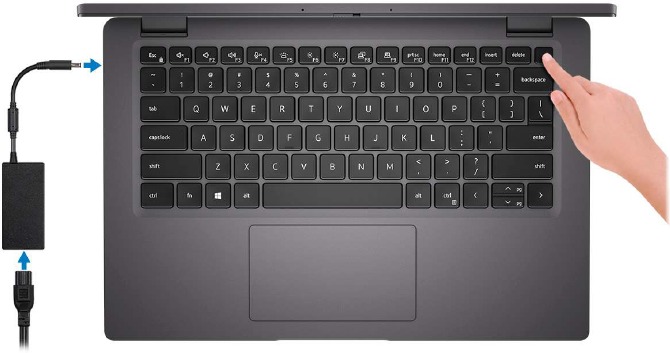

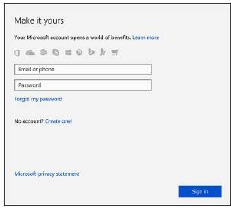






















Need help?
Do you have a question about the Latitude 7310 and is the answer not in the manual?
Questions and answers